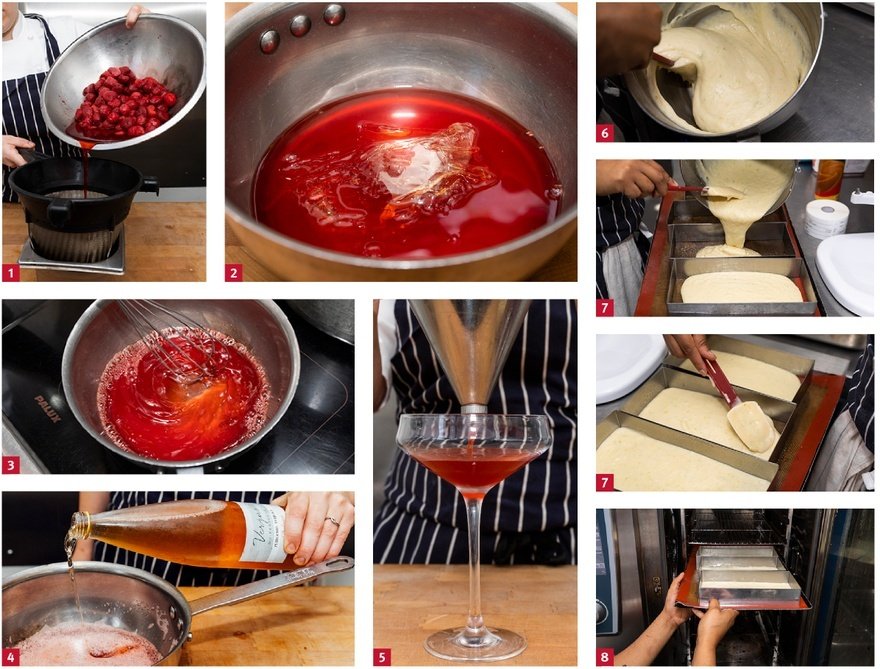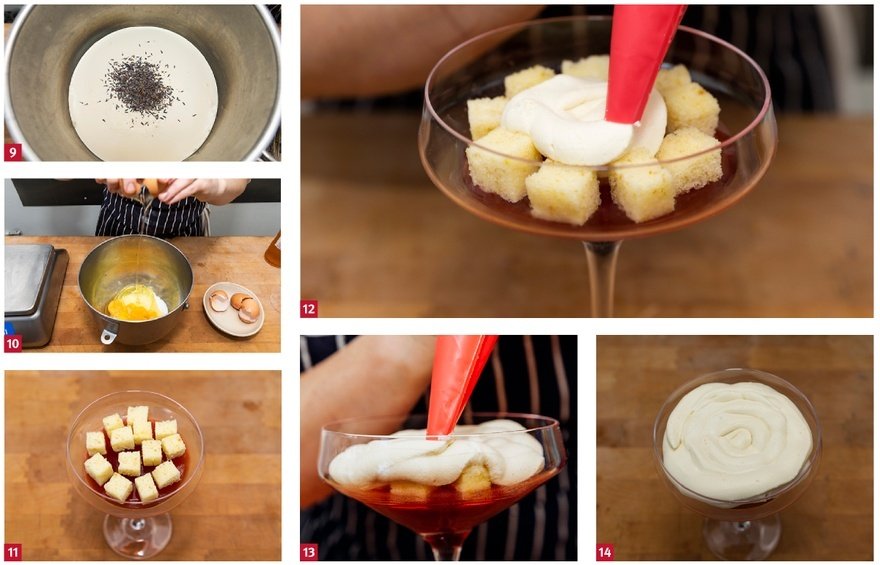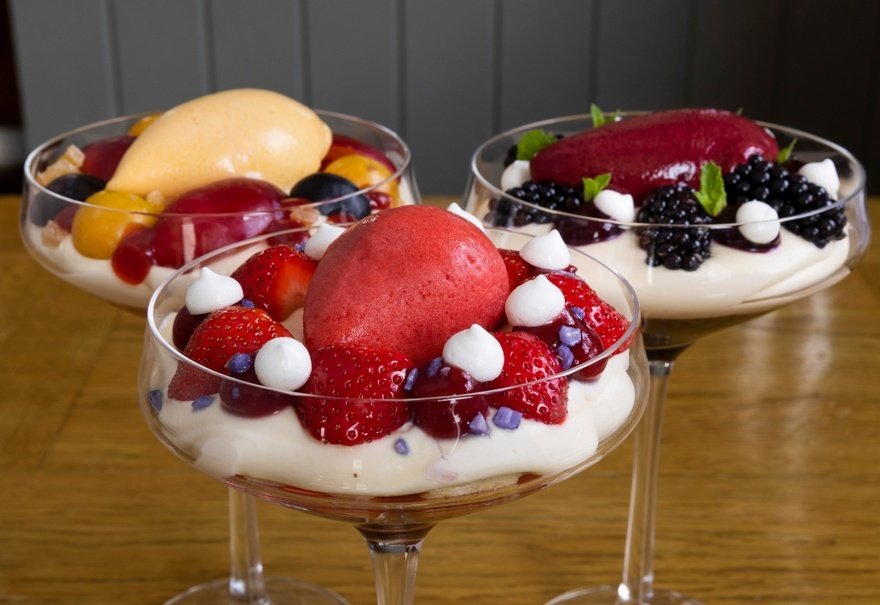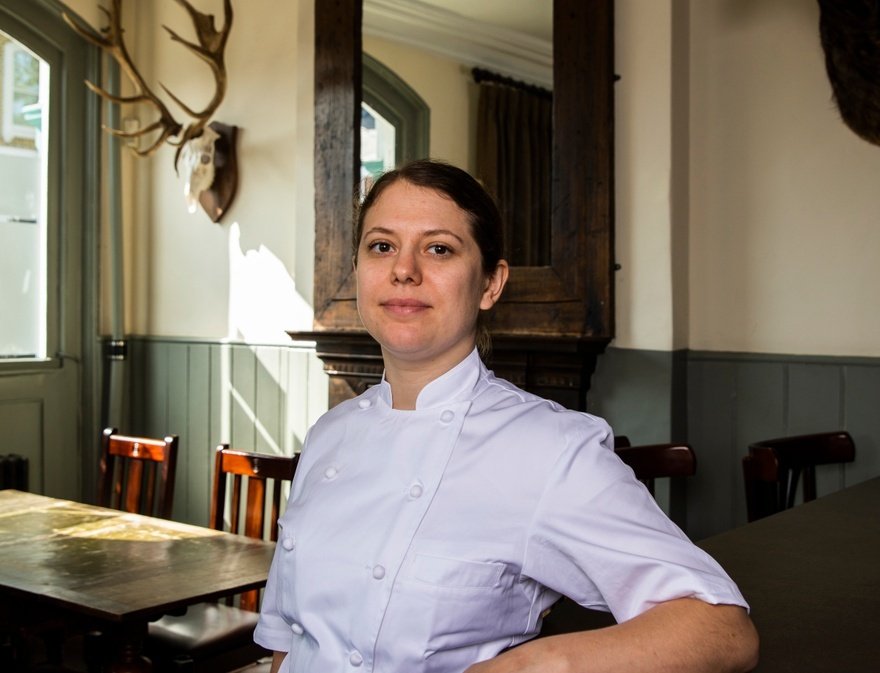At the Harwood Arms, London's only Michelin-starred gastropub, head chef Sally Abé puts locality and seasonality at the top of the menu. Her strawberry lavender trifle is a modern take on the quintessential English dessert, as Michael Raffael explains
For the past 250 years or so, every generation, just about, has reinvented the trifle. It's a fair pointer to the state of the nation's tastes and cookery talents. After the Second World War, for instance, trifle was a ‘treat' of dry, crumbled sponge set in synthetic fruit jelly with a powdered custard topping. Move on a few years and waiters were spooning out dollops from the sweet trolley as an alternative to the gâteau and fruit salad.
Sally Abé at the Harwood Arms in Fulham, London combines past and present in her trifles. A seasonal fruit jelly acts as a base. Cubes of steamed citrus sponge form the second layer. A chilled, flavoured sabayon doubles as the custard and the syllabub toppings that were integral to 18th-century trifles. The creation is garnished with fresh fruit, meringue pearls and sorbet, and served in a Martini glass.
The recipe lends itself to adaptation. Whether Abé's dishing up a trifle with berries in midsummer or rhubarb in February, the basic recipe balance stays the same. This template lets her experiment at will: switching between bay and lavender in the sabayon, or a sweet wine, liqueur or even verjuice in the fruit jelly. The toppings and sorbet, part of the finished dish, give her extra options.
The word trifle itself, when first used, implied something less than the statuesque sweetmeat centrepieces served at court banquets. It was homely and accessible. This may be at the root of its longevity: it has the common touch and never loses its appeal.
Planning
The Harwood Arms prepares batches of trifle daily, usually 25 portions.
- Make and set the jelly in Martini glasses
- Steam and dice the sponge
- Cook and chill the sabayon
- Assemble portions to order
- Other elements: lavender meringue pearls, strawberry sorbet and strawberry gel
Cost
Abé's £49.50 three-course menu lists five starters, five mains and five desserts. "We only use fruit at the height of its season to ensure we get the best price, so it's good for our gross profit," she says.
Strawberry jelly
Ingredients for half a batch, about 12 portions
- 1kg of defrosted, ripe strawberries
- 50g-100g caster sugar (use 50g with a strawberry liqueur, 100g with verjuice)
- 50ml water
- 3½ leaves softened gelatine
- 125ml strawberry liqueur or 125ml verjuice
Steam the strawberries for 30 minutes at 100°C. Allow all the juice to drain from them, so as to obtain 400ml-500ml of juice (1). Dissolve the sugar in water and add it to the juice (2).
Heat the liquid with the gelatine, stirring till it dissolves, but don't simmer or cook it (2,3). Add the liqueur or verjuice (used in the picture (4), cool and pour about 60ml into each martini glass (5). Leave to set in the chiller cabinet.
Steamed sponge
Ingredients for 25 portions
- 175g cake flour
- 4g baking powder
- 40g milk powder
- 3 eggs
- 225g caster sugar
- Grated zest of 1 lemon and 1 lime
- 50g unsalted butter, melted
Sift the flour, baking powder and milk powder. Whisk the eggs and sugar to the ribbon with a KitchenAid or similar (6). Add the zest. Fold in the flour and finally the melted butter.
Pour about 100g of the batter into each of six 30cm x 10cm baking tins (7). Steam at 100°C for 20 minutes (8). Cool, turn out and cut into 1cm cubes.
Lavender sabayon
Ingredients
- 600ml whipping cream
- 10g lavender
- 4 eggs
- 150g caster sugar
Bring the cream and lavender to the boil in a medium-sized pan (9). Leave to infuse, strain into a fresh pan or bowl, but don't cool.
Whisk the eggs and caster sugar until they whiten and thicken (10). Mix a third of the still-hot cream with the eggs to prevent cooking them. Then fold in the rest.
In a fresh pan, heat the mixture to 82°C over a gentle heat, stirring continuously to thicken. Chill and fill piping bags with the sabayon.
Other trifle elements
These include Pacojet strawberry sorbet (80% fruit purée, sugar and glucose), lavender meringue pearls (Italian meringue made with lavender-flavoured sugar) and strawberry gel (1kg of sweetened fruit purée thickened with 12g agar agar).
Ingredients for a single serving
- Martini glass with 60g set strawberry jelly
- 12 cubes (approximately) of steamed sponge
- 60g-70g (approximately) of lavender sabayon
- 4-6 halved strawberries (Mara des Bois if possible)
- 6 meringue pearls
- Strawberry gel
- Crystallised lavender petals
- 60g quenelle strawberry sorbet
Cover the strawberry jelly with cubes of sponge (11). Pipe the sabayon over them (12; 13; 14). Arrange the strawberry halves in a ring around the edge (15).
Fill the gaps with meringues and piped gel (16). Sprinkle a few crystallised lavender petals to add a lavender colour (17). Finish with the strawberry sorbet (18).
Sally Abé's seasonal fruit trifles
Summer
Strawberry and lavender
Late summer
Damson
Blackberry and bay
Late summer to autumn
Plum and ginger
Autumn
Quince and mead
Late winter
Forced rhubarb and sherry
Trifle from the 18th century
Martha Bradley recommends in the 18th-century cookbook The British Housewife: "Break into a large bowl some Naples biscuits [sponge fingers], macaroons and ratafia cakes. Cover the bottom of the bowl with these and pour over as much sack [sherry] as will just wet them through. Make a boiled custard but more thick; set it by to cool and when quite cold pour it over them; and then pour in a syllabub over that and garnish with currant jelly and ratafia cakes."
Sally Abé
Commenting on the presentation of her trifles, Sally Abé concedes that people do eat with their eyes. "They're pretty, but not girly. I don't want my food to look overly feminine," she says. What matters more to her is taste.
The Harwood Arms head chef makes an eloquent spokesperson for co-owners Brett Graham, Mike Robinson and Edwin Vaux. Their Fulham pub, London's only Michelin-starred pub, dishes up fare that, a few years back, the guides called ‘modern British'.
After two years, the alumna of the Ledbury and Elystan Street feels bedded into her first job running a kitchen. She says: "You work as a chef for so many years, but you never have the opportunity to put a dish on the menu. Then you are in charge and suddenly it's, ‘I've never done it before'.
"Essentially, though, you grow into it. You figure out what you like and what you don't. I'll only cook food I like eating.
"I love roasting a piece of meat or cooking fish in a pan. I don't want to plan three days ahead. I want things fresh on a plate, ready to go there and then. There's a place for molecular and sous vide, but that's not what excites me."
She's unashamed about waving the ‘locally sourced' flag. "We don't do chocolate, we don't do pasta, we don't do rice. The only carbs we use are potatoes and pearl barley, because they're grown here. It might seem limiting, but it forces you to be more creative."
Naturally, Robinson's passion for wild food influences her choice of meat, especially game. She buys her fruit from Brogdale Farm in Kent, which has one of the world's largest collections of fruit trees and bushes. It supplies her with varieties grown for their flavour.
Working with raw materials with a strong British pedigree has led her to research dishes that connect with the past. "I spend a lot of time looking through old recipe books, finding something that catches my eye and then putting my own spin on it using lesser-known ingredients – for example, a sticky toffee pudding that's made with medlars," she says.
The other piece of the culinary puzzle is that ingredients have to be seasonal. When she had access to marrowfat peas, she updated London particular soup (named after the soot particulate-laden "peasouper" fog that was prevalent in 19th-century London). "I served it with venison ham croquettes," she says.
Continue reading
You need to be a premium member to view this. Subscribe from just 99p per week.
Already subscribed? Log In













